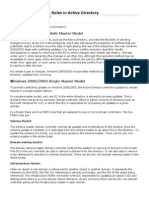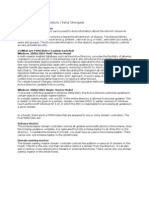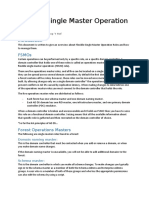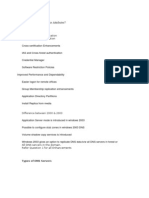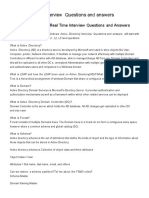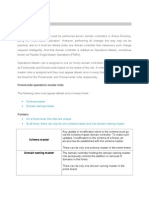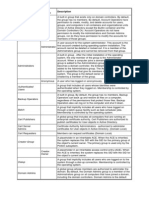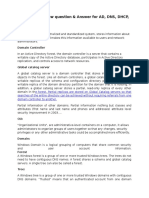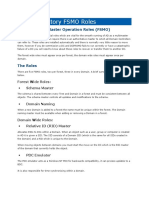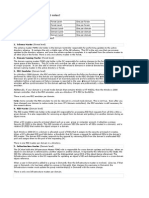Flexible Single Master Operations
Windows 2000/2003 Multi-Master Model
A multi-master enabled database, such as the Active Directory, provides the flexibility of allowing changes
to occur at any DC in the enterprise, but it also introduces the possibility of conflicts that can potentially
lead to problems once the data is replicated to the rest of the enterprise.
One way Windows 2000/2003 deals with conflicting updates is by having a conflict resolution algorithm
handle discrepancies in values by resolving to the DC to which changes were written last (that is, “the
last writer wins”), while discarding the changes in all other DCs. Although this resolution method may be
acceptable in some cases, there are times when conflicts are just too difficult to resolve using the “last
writer wins” approach. In such cases, it is best to prevent the conflict from occurring rather than to try to
resolve it after the fact.
For certain types of changes, Windows 2000/2003 incorporates methods to prevent conflicting Active
Directory updates from occurring.
Windows 2000/2003 Single-Master Model
To prevent conflicting updates in Windows 2000/2003, the Active Directory performs updates to certain
objects in a single-master fashion.
In a single-master model, only one DC in the entire directory is allowed to process updates. This is similar
to the role given to a primary domain controller (PDC) in earlier versions of Windows (such as Microsoft
Windows NT 4.0), in which the PDC is responsible for processing all updates in a given domain.
In a forest, there are five FSMO roles that are assigned to one or more domain controllers. The five FSMO
roles are:
Schema Master:
The schema master domain controller controls all updates and modifications to the schema. Once the
Schema update is complete, it is replicated from the schema master to all other DCs in the directory. To
update the schema of a forest, you must have access to the schema master. There can be only one
schema master in the whole forest.
Domain naming master:
The domain naming master domain controller controls the addition or removal of domains in the forest.
This DC is the only one that can add or remove a domain from the directory. It can also add or remove
cross references to domains in external directories. There can be only one domain naming master in the
whole forest.
Infrastructure Master:
When an object in one domain is referenced by another object in another domain, it represents the
reference by the GUID, the SID (for references to security principals), and the DN of the object being
referenced. The infrastructure FSMO role holder is the DC responsible for updating an object’s SID and
distinguished name in a cross-domain object reference. At any one time, there can be only one domain
controller acting as the infrastructure master in each domain.
Note: The Infrastructure Master (IM) role should be held by a domain controller that is not a Global
Catalog server (GC). If the Infrastructure Master runs on a Global Catalog server it will stop updating
object information because it does not contain any references to objects that it does not hold. This is
because a Global Catalog server holds a partial replica of every object in the forest.
�As a result, cross-domain object references in that domain will not be updated and a warning to that
effect will be logged on that DC’s event log. If all the domain controllers in a domain also host the global
catalog, all the domain controllers have the current data, and it is not important which domain controller
holds the infrastructure master role.
Relative ID (RID) Master:
The RID master is responsible for processing RID pool requests from all domain controllers in a particular
domain. When a DC creates a security principal object such as a user or group, it attaches a unique
Security ID (SID) to the object.
This SID consists of a domain SID (the same for all SIDs created in a domain), and a relative ID (RID)
that is unique for each security principal SID created in a domain. Each DC in a domain is allocated a pool
of RIDs that it is allowed to assign to the security principals it creates.
When a DC’s allocated RID pool falls below a threshold, that DC issues a request for additional RIDs to
the domain’s RID master. The domain RID master responds to the request by retrieving RIDs from the
domain’s unallocated RID pool and assigns them to the pool of the requesting DC. At any one time, there
can be only one domain controller acting as the RID master in the domain.
PDC Emulator:
The PDC emulator is necessary to synchronize time in an enterprise. Windows 2000/2003 includes the
W32Time (Windows Time) time service that is required by the Kerberos authentication protocol.
All Windows 2000/2003-based computers within an enterprise use a common time. The purpose of the
time service is to ensure that the Windows Time service uses a hierarchical relationship that controls
authority and does not permit loops to ensure appropriate common time usage.
The PDC emulator of a domain is authoritative for the domain. The PDC emulator at the root of the forest
becomes authoritative for the enterprise, and should be configured to gather the time from an external
source.
All PDC FSMO role holders follow the hierarchy of domains in the selection of their in-bound time partner.
In a Windows 2000/2003 domain, the PDC emulator role holder retains the following functions:
Password changes performed by other DCs in the domain are replicated preferentially to the PDC
emulator.
Authentication failures that occur at a given DC in a domain because of an incorrect password are
forwarded to the PDC emulator before a bad password failure message is reported to the user.
Account lockout is processed on the PDC emulator.
Editing or creation of Group Policy Objects (GPO) is always done from the GPO copy found in the PDC
Emulator’s SYSVOL share, unless configured not to do so by the administrator.
The PDC emulator performs all of the functionality that a Microsoft Windows NT 4.0 Server-based PDC or
earlier PDC performs for Windows NT 4.0-based or earlier clients.
This part of the PDC emulator role becomes unnecessary when all workstations, member servers, and
domain controllers that are running Windows NT 4.0 or earlier are all upgraded to Windows 2000/2003.
The PDC emulator still performs the other functions as described in a Windows 2000/2003 environment.
At any one time, there can be only one domain controller acting as the PDC emulator master in each
domain in the forest.

